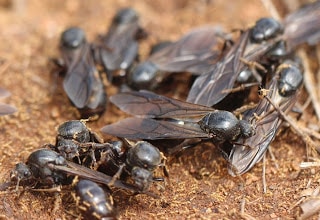The researchers examined the antimicrobial properties associated with twenty species of ants. They did this by using a solvent that removes all the substances on the surface of each ant's body. These materials were then transferred to a bacterial solution and compared to a bacterial solution in a control group

By Or Amr
Ants, like humans, deal with diseases. In order to deal with disease-causing bacteria, some ants create antibiotics. A new study conducted by a group of researchers from the University of Arizona's Biomimicry Center has identified the use of antimicrobial agents in some ant species. 40% of the ant species tested did not appear to produce antibiotics.
For the purpose of the study, the researchers examined the antimicrobial properties associated with twenty species of ants. They did this by using a solvent that removes all the substances on the surface of each ant's body. These materials were then transferred to a bacterial solution and compared to a bacterial solution in a control group.
In cases where the bacteria in the experimental group that contained materials from the ants grew more slowly or less than the control group, this meant that an antimicrobial factor was activated. For example, in an experiment that contained a compound from the thief ant, no bacterial growth was observed at all.
In fact, the researchers discovered antimicrobial agents in twelve of the twenty types of ants tested, while in the other eight types no use of antibiotics was detected, or at the very least, the antimicrobials in their exoskeleton were not effective against the bacteria in the experiment. One of the most striking results of the study was the discovery that the Thief Ant has the strongest antibiotic effect of all the species tested. Until the study, no one had shown that the thief ant used antimicrobials.
The prevailing assumption until the experiment was that most, or even all, ant species have antimicrobial factors. But the research, as mentioned, showed otherwise.
The research may have practical implications in the search for new types of antibiotics that can be used by humans.
"These findings show that ants can be a source of new antibiotics, which will fight diseases that affect humans," says Clint Penick, a researcher at the Biomimicry Center at Arizona State University.
This fact emphasizes the importance of refining the species to those that can really try and guarantee results in biomedical research. For example, the thief ant is close to the large fire ant, which is known for the antimicrobial properties of its venom, but in an experiment it turned out that the antimicrobial factors of the thief ant were more effective against the bacteria.
Despite all that has been said, the researchers point out that the research is limited, among other things, because the scientists used only one bacterial agent for the experiments, and therefore it is not possible to know how each of the species will react to another type of bacteria.
In the future, the researchers are interested in investigating the struggle of ant species against different types of bacteria and also to examine additional strategies that ants may use to protect themselves from bacterial pathogens.

One response
Interesting, but again and again translators of articles confuse the concepts of sorting
And thus cause confusion in the body of the article
Therefore, it is appropriate for them to learn and internalize that:
Wherever in the original it says species, it should be translated as species (not species)
They will learn and internalize that when Genus is written in the original, the Hebrew translation is type,
And again Genus = type, species = species.
Please study and internalize...